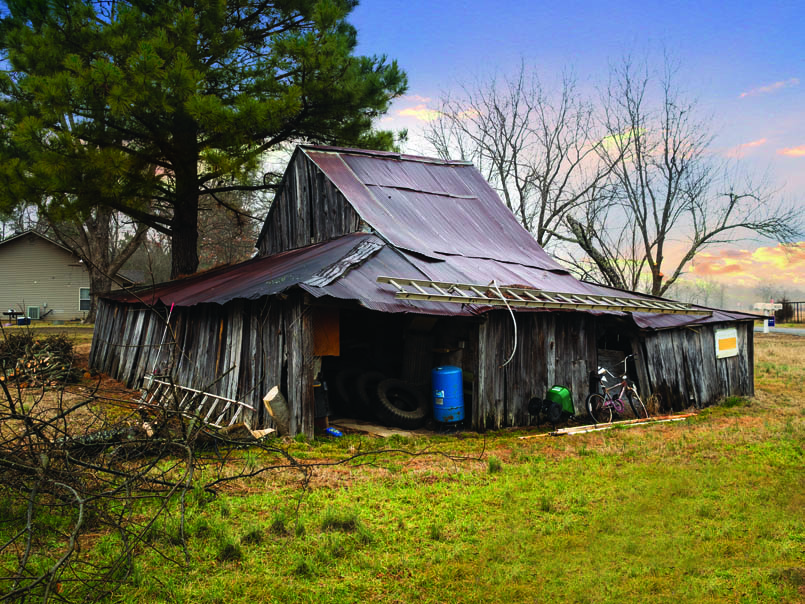05 Mar 2021 Century-old barn is a real piece of work
By Dwain Hebda
Arkansas is a land of things that last. The same emerald mountains that attracted our ancestors thrill us today; the same sparkling waters that refreshed their bodies restore our souls.
The best things about us stand the test of time.
Take the Casey family, a farming clan who settled in Faulkner County before the dawn of the 20th century. James Madison “Sam” Casey, the son of Irish immigrants, arrived here like many of his day to coax a living from the land. It was a hard existence, marked by manual labor and the whims of weather, a legacy Sam passed down to his children and theirs.

“I remember a lot of work. I remember that,” said Russell Casey, Sam’s grandson. “We were poor as Joe’s turkey. We just survived.”
Russell’s parents, Rufus and Bessie Casey, would eventually move their family to Mississippi County, where the large brood – 15 kids, 13 of whom survived childhood – would grow up working cotton and corn. But there’s plenty he remembers about the ancestral ground, particularly the log barn, a local landmark built somewhere around 1900 on a rural patch between Mount Vernon and Enola, where it stands to this day.
“My grandfather built that barn,” said Russell, seventh in the line of siblings. “It belonged to my grandfather. It was there when I was born and I’m 93 years old.”
The barn was the gathering place for the family after a hard day’s work or in the brief respite of Sunday, the only day the labor paused. Sam’s tri–level barn was an impressive sight to the neighbors and nearly irresistible to the children in that short window of life before they were old enough to walk behind a horse–drawn plow or hoe the fields.
Once, Russell, his brother Faber, and his cousin Eldon, defied the standing order to stay out of their grandpa’s barn and climbed to the third level. Thinking he was on the second level and headed for a pile of corn, Russell jumped, landed wrong and broke his arm. Another brother, Quention, was summoned to take the injured boy back to his parents’ house to await the country doctor.
“That’s when we lived at Caney Creek,” Russell said. “The creek was pretty close to the house. In fact, Caney Creek was a good 500 feet wide when we crossed it on a horse with that broken arm that I had. If that horse had went down, there wouldn’t have been no horse, or Russell, or my brother either. I was only 5 or 6 years old, so I didn’t think a thing about it. I wasn’t scared at all.”
Today the barn remains a symbol of the hardships and joys of the pioneering family, marking the seasons for well over a century in the lives of its members. After Rufus and Bessie relocated to Northeast Arkansas, where they lived the spartan life of sharecroppers, Russell grew up and entered World War II, serving in Japan. Returning home and failing to find work, he relocated to Indiana in 1951, raising his family on jobs at the Pullman Co. and U.S. Steel.
For his brother Randall, things worked in reverse. Number 14 of the 15 kids, he didn’t grow up in the shadow of the barn but around Jonesboro. As time and fortune would have it, however, he’d migrate back to Central Arkansas, where he worked for AT&T and now lives in the same general neck of the woods as his forefathers.
“All my brothers and sisters worked hard on that farm,” said Randall, 84. “I remember we did take Sunday off. All the kinfolk would come see you, and we’d all get together and have maybe a chicken dinner or something like that.
“I didn’t finish school, but soon as I got 18, I went to work at Conway at the shoe factory. From there, I went to Little Rock and worked up there at Arkansas Electric for a couple years. Then I went to AT&T.
“I married when I was about 20 years old, and we had two kids, two boys.” He added proudly, “Both of them finished school.”
Another Casey sibling, Norma, married Carmon Varner and raised her family in the area. Her daughter, Janice Housley of Mabelvale, didn’t play in the family barn’s lofts or attend family picnics like the previous generations, but the lore of the building came to fascinate her as an adult.
“To be perfectly honest, I never paid any attention to the barn as a child,” Janice said. “Not until I became an adult did I realize the significance of rural life and its many hardships. We went up there to visit the barn and some other relatives who live on that site now where the barn sits. It just brings back a lot of memories when they talk about all the things that happened in their lives.”
Janice said she and her cousins recently decided to start recording these stories straight from the mouths of their elders to preserve the family legacy. Inevitably, the barn works its way into the narrative.
“We wanted to write these accounts because they summarize their life, how much they all depended upon each other,” she said. “Not all of it was good; sometimes there wasn’t enough to eat and they had inadequate clothing. Some things they would just as soon forget. To me, basically, the barn represents their struggles.”
- The pinnacle of success - June 1, 2025
- Five-Oh-Ones to Watch 2025: Aaron Farris - December 31, 2024
- Julia Gaffney brings medals and mettle home to Mayflower - October 30, 2024








